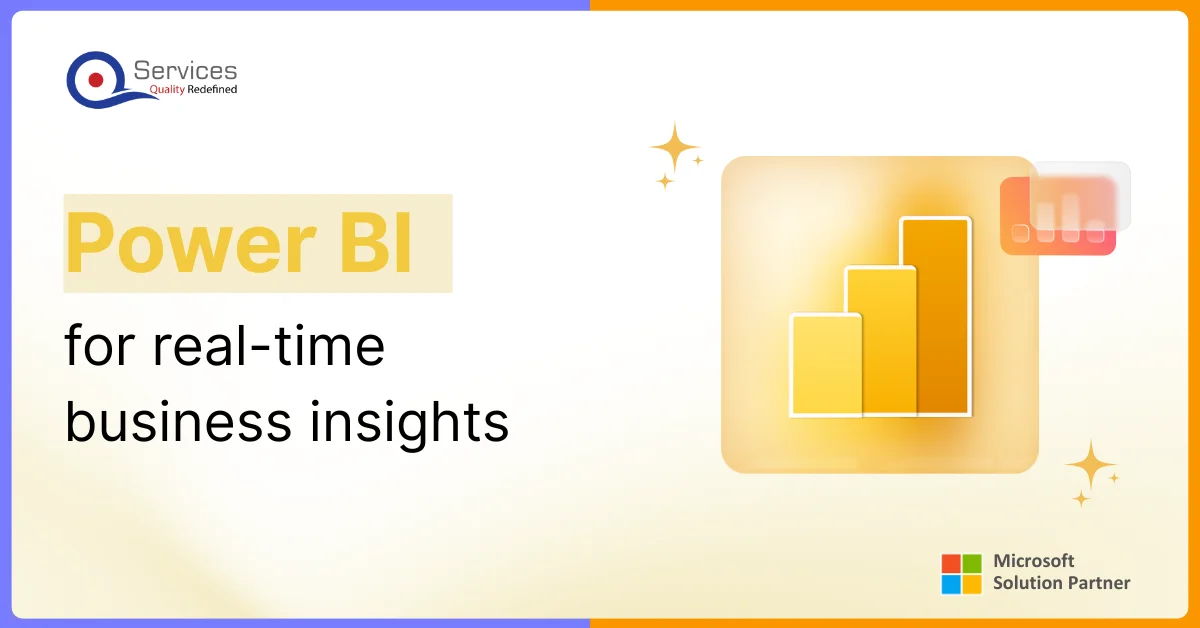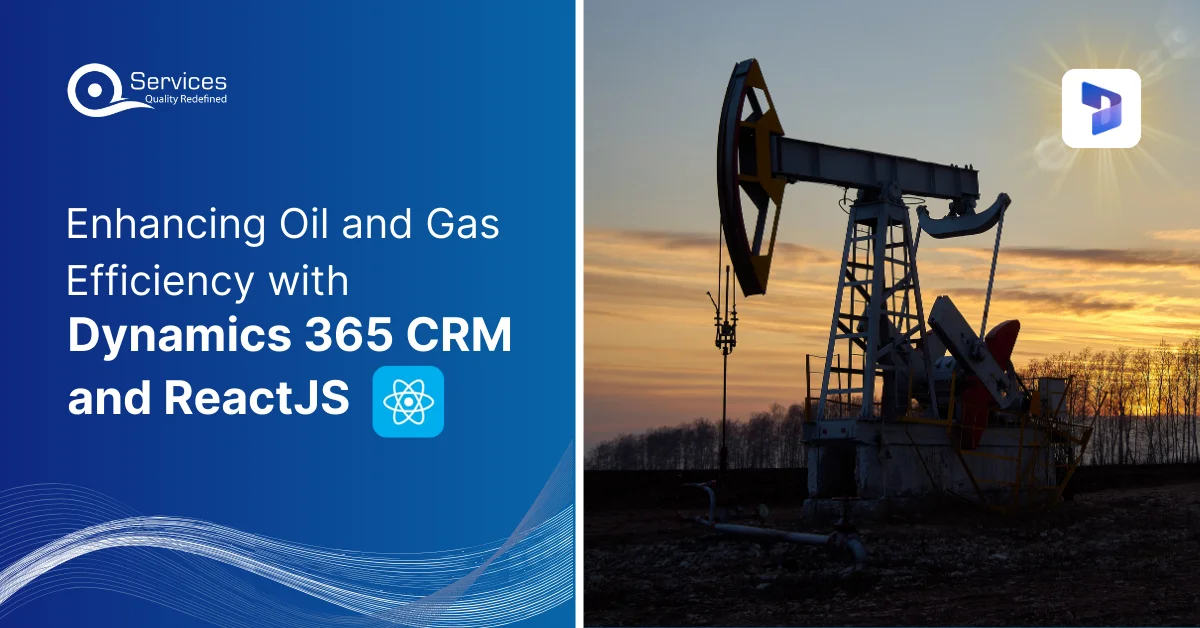
Home » Enhancing Oil and Gas Efficiency with Dynamics 365 CRM and ReactJS

The international oil and gas sector is a massive deal serving as a major player in the worldwide economy. Yet, it’s always under the gun to get better at being efficient, cutting down costs and getting on board with digital changes. Companies are catching on to the fact that they need cool tech like Dynamics 365 CRM and ReactJS if they want to keep things running smooth and make smarter choices. When you mix a CRM for oil and gas with some top-notches React JS application development, that’s when the magic happens – we’re talking serious boosts in efficiency and innovation. This post is all about the awesomeness of using Dynamics 365 CRM for oil and gas efficiency along with ReactJS for oil and gas digital transformation to switch things up in the industry.
The oil and gas field has loads of parts like exploring, making holes, pulling stuff out of the ground, refining, and spreading it all around. To manage these bits, you need tough systems that keep up with people you sell to, keep track of what you own, and make work flow . A CRM for energy such as Microsoft Dynamics 365 CRM, gives everyone a place to get all this stuff sorted.
Solutions for “CRM oil and gas” aim to handle customer info, monitor sales progress, and make service offerings better. Dynamics 365, take Dynamics 365 order management” as an instance, equips businesses to handle orders with more efficiency slicing down on waiting times. Oil and gas businesses employing features like “Dynamics 365 order management,” can mesh supply chain details together making sure there’s smooth teamwork among supply folks, contractors, and buyers.
A key characteristic is Dynamics 365 intelligent order management. It uses AI to forecast needs, manage stock, and speed up order processing. This intelligent ordering system upgrades the game for oil and gas firms intent on cutting wait times and allocating resources better. Be it sorting out gear needs for a drilling spot or sorting fuel delivery, Dynamics 365 CRM for oil and gas process optimization makes everything more efficient.
Unlike regular CRM tools, Dynamics 365 CRM customizes super well so it’s just perfect for the energy industry’s special challenges. Take Dynamics 365 CRM for oil and gas asset management, for example. Companies get to keep an eye on how equipment’s doing, sort out when to do maintenance, and keep tabs on the life story of their gear. This kind of thing lowers the chance of things going wrong and makes sure the important stuff lasts longer.
Also, Dynamics 365 CRM for oil and gas workflow automation kicks out the need to do stuff by hand, like all that paperwork needed for sticking to the rules or saying yes to things happening out in the field. When you get machines to do the repeat stuff, the crew can put their brains to good use planning big things and talking to customers. What’s the upshot? They get more stuff done and spend less money doing it.
Businesses that already use BigCommerce get even more by tying BigCommerce D365 to Dynamics 365 CRM making a connected world. This combo helps people selling oil and gas stuff because it mixes web sales with CRM smart points giving customers a smooth run-through.
Sure, Dynamics 365 CRM is great for managing data and making processes better, but the stuff people see and use is super important too. That’s where ReactJS comes into the picture. It’s a top-notch JavaScript library that lets the tech folks build quick, big, and easy to use stuff that fits right into the oil and gas world.
Developing oil and gas tools with ReactJS is changing how firms use their info and connect with folks involved. Imagine a dashboard that lets you watch production live or a space where customers help themselves. Using React.js, we can cook up quick-to-respond and snappy apps. React JS software building is super flexible, so teams can whip up tailored apps that fit right into Dynamics 365 CRM making things nicer for users.
When these techs join forces, that’s when the magic happens. Making oil and gas stuff better with Dynamics 365 CRM gets a huge boost from a ReactJS front-end. Check out how blending these sparks more productivity in important spots:
In the oil and gas sector, companies deal with a ton of numbers—from deep-earth scans to how much oil they pump. Using ReactJS for oil and gas data visualization lets creators whip up cool clickable charts and patterns that turn all those numbers into something you can use. When you mix these pics with Dynamics 365 CRM, the big bosses can get a live look at how sales are going, what’s up with the gear, and where things are getting stuck.
Take this: a dashboard made with React that takes numbers from Dynamics 365 can show how much oil you’re pulling out of the ground right next to the customer orders. This helps the crew get the right amount of oil to where it’s needed. Knowing this stuff right away is super important when you gotta make quick calls in a super busy business.
Everyone on the team, from the folks in the field to the big bosses and the clients, needs top-notch tools to get their work done right. Stick “ReactJS for oil and gas user interfaces” on your apps, and you’re looking at something that’s a breeze to use, not just something that gets the job done. By picking “React JS application development” to put together those smart little screens for your field techs or fancy office setups, businesses are making sure everyone’s on the same page.
Hook it up with “Dynamics 365 CRM,” and bam, you’ve got a magic doorway to everything from who’s buying what to the nitty-gritty on the gear. It’s all about nailing that smooth vibe cranking up how much folks can get done, and making sure no one’s wasting time learning the ropes.
Oil and gas jobs often get stuck due to manual work. “Dynamics 365 CRM for oil and gas workflow automation” makes things digital by turning tasks such as getting approvals, billing, and making sure we’re following the rules into online stuff. And then, “ReactJS” makes the user’s screen better by showing new info and alerts right away.
Now, picture a field tech putting in a request to fix something using an app made with React. The “Dynamics 365 CRM” system takes that request and sends it off to the correct crew updating the thing that needs fixing and letting the boss know—all of this without the need for paper or back-and-forth emails. This combo of tools cuts down on wasted time and keeps mistakes to a minimum.
The oil and gas sector is getting a tech upgrade, and “ReactJS for oil and gas digital transformation” is super important in this change. By making new apps using “ReactJS application development,” firms are leaving old tech behind for nimble, cloud stuff.
Mixing it with “Dynamics 365 CRM” means companies can go digital from getting customers to looking after assets. The thing with “React JS development” is, it’s got room to grow, so as the biz gets bigger, its apps can step up their game and still run smooth.
Okay, let’s break down how “Dynamics 365 CRM” and “ReactJS” are doing cool things in the real world:
Get free Consultation and let us know your project idea to turn into an amazing digital product.

If you’re getting into React JS for oil and gas projects, check out these React hints to get things done faster:
Rooted in developpement React, these methods help teams pump out rock-solid solutions that live up to the tough standards of the industry.
Mixing Dynamics 365 CRM with ReactJS slams down some real-deal perks:
Putting Dynamics 365 CRM for oil and gas efficiency alongside ReactJS in oil and gas software solutions sure ain’t a walk in the park. You’ll need savvy devs who know their way around both systems, and yeah, starting up ain’t cheap. But check it: quicker processes sharper data analysis, and customers grinning ear to ear make it all worth it in the end.
As the sector changes, Dynamics 365 CRM and ReactJS keep pushing new ideas forward. Stuff like smart analytics powered by AI and hooking up with the Internet of Things will boost what they can do even more. So taking Dynamics 365 intelligent order management as an example, this tech might guess when gear’s gonna break using Internet of Things info. And then there’s ReactJS for oil and gas data visualization showing this stuff off the second it happens.
Share your project idea with us. Together, we’ll transform your vision into an exceptional digital product!

At this critical juncture, the oil and gas sector cannot do without efficiency boosts and innovative strides. The use of Dynamics 365 CRM to up oil and gas efficiency along with ReactJS to build oil and gas apps can shift how companies rock their operations. They can nail it crunching numbers, making workflows better, or making sure users get the best experience. No kidding, this killer combo is laying down the tracks for an industry that’s way smarter and nimble.
For any biz that’s all in for this shift, slapping together a CRM for the energy sector with ReactJS app creation is not just another set of tools—it’s the secret sauce to get ahead. Get on it and discover how Dynamics 365 CRM and ReactJS can kick your oil and gas business operations into high gear.
Yes, it’s scalable and can be implemented with essential features first, expanding as the company grows, making it accessible for businesses of all sizes.
It allows companies to monitor equipment conditions, schedule maintenance, track asset lifecycles, reduce downtime, and extend the lifespan of critical oil and gas equipment.
Dynamics 365 generally offers better integration with Microsoft tools and field service capabilities, while Salesforce has a larger marketplace of industry apps.
Companies typically save through reduced manual processes, improved resource allocation, minimized equipment downtime, streamlined operations, and enhanced decision-making capabilities.
Dynamics 365 offers better customization and modern interfaces while SAP provides deeper industry-specific functionality. Dynamics typically has faster implementation and lower upfront costs.
Well permitting, equipment maintenance scheduling, production allocation, regulatory reporting, contractor management, and crude delivery scheduling can all be automated.
Yes, by tracking near-misses, automating safety procedures, managing training certifications, documenting inspections, and identifying risk patterns across operations.
Common challenges include legacy system compatibility, handling intermittent connectivity in remote locations, data transformation, and synchronizing large datasets securely.
They typically need 4-8 hours focused on data entry procedures, offline operation, synchronization protocols, troubleshooting common issues, and essential maintenance workflows.

Secure access is vital for organizations managing digital identities in today’s landscape. While both CIAM and IAM secure user identities, they serve different purposes — CIAM for customers and IAM for employees. This article explores their key differences and how to choose the right system.

For decades, traditional banking systems handled only basic transactions. The digital era exposed their limitations in speed and adaptability. Evolved core banking now powers seamless, future-ready financial services.

As digital expectations grow, customers now demand speed, ease of use, and 24/7 availability. To meet these demands at scale, digital-only banks choose business process automation in the banking industry to deliver consistent, responsive, and personalized service.

Founder and CEO

Chief Sales Officer
